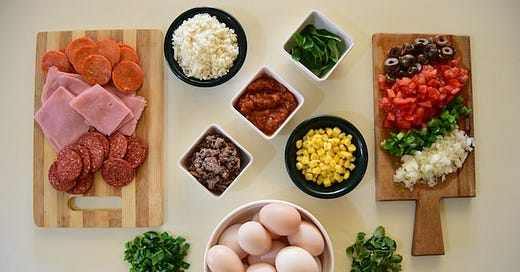Applying Mise En Place to Data Operations
In operations, everything works better when it has its own place. Look to the cooking concept of Mise en place for inspiration. Read: "Everything Starts Out Looking Like a Toy" #175
Hi, I’m Greg 👋! I write weekly product essays, including system “handshakes”, the expectations for workflow, and the jobs to be done for data. What is Data Operations? was the first post in the series.
This week’s toy: a developer built a “radar” app to help his toddler find planes in the sky and released it to the App Store. The best part about this explanation? The step-by-step logic to go from idea to iteration to finished app. Edition 175 of this newsletter is here - it’s December 11, 2023.
If you have a comment or are interested in sponsoring, hit reply.
The Big Idea
A short long-form essay about data things
⚙️ Applying Mise en Place to Data Operations
“Mise en Place” is a French culinary term for putting everything in its place. It’s a way to prepare your kitchen for cooking, and more importantly, a technique to make it possible for you to do your best work.
Chef Christine Waltermyer explains the concept:
The five basic steps of Mise en Place
When you prepare to cook, there are a few basic steps to remember.
Step 1: Read the recipe
Reading the recipe helps you to know the outcome you’re trying to achieve. You’ll need specific tools, ingredients, and a process to complete the recipe.
“Winging it” might work once for a recipe you have internalized or done many times, but reading the process every time makes it more likely to do it right.
Step 2: Gather and prepare your ingredients
Now that you know what’s needed, identify and get the items for your recipe. If you are missing something, you might make substitutions or select another option. At this point, you know if you have gaps.
Now, prepare the ingredients in your recipe. Measuring and chopping gets you going and thinking about individual ingredients and steps.
Step 3: Arrange ingredients
After the items are ready, place them in appropriate size bowls in the order they will be used. If you don’t need to think “what’s next” there are fewer mistakes to make.
The series of ingredients also tells you the order of operations for the recipe.
Step 4: Prepare the workspace
Are you using multiple pans or dishes to create your food? Do you need any special implements or machines to get the job done? If your ingredients are not already in the right place, put them where they will be used in the workspace.
Step 5: Prepare the equipment
Now we’re ready to start. Pre-heating the oven, deglazing a pan, or greasing a pan to bake are our next steps. You can have the best ingredients in the world and still ruin the preparation by missing steps in your recipe.
How does Mise en Place apply to Data Operations?
The concepts of cooking map well to operations.
At the beginning of every process, you need to write it out so to know the outcome you’re trying to achieve, the ingredients you’ll need, and the preparation necessary to transform information to get results.
Past you (and future you) depend on knowing if you’ve done this before, what happened, and how to debug and find problems with existing process.
A complex process is not better than a simpler one. Each piece gets better if you keep breaking it down from the initial idea into smaller components.
Mise en Place for data operations:
requires thinking about what you do before you do it
implies that you do things the same way every time through the process
saves you from making simple mistakes
What does this look like?
Reading the recipe: read and write a process to explain what will be done
Gather ingredients: know what your data looks like and how it needs to be transformed
Arrange ingredients: understand the order of operations
Prepare the workspace: test with known data, then proceed
Prepare the equipment: do you what you need to do to run and log results
Using the concepts of Mise en Place improves the individual steps and outcomes for data operations.
What’s the takeaway? Like a sous chef preparing ingredients for a recipe, you can prep data for a process. Knowing how the pieces fit together is the first step to repeating success.
Links for Reading and Sharing
These are links that caught my 👀
1/ Focus matters - when the team at Github redesigned the comment box, they didn’t realize how much users would revolt over what they considered a very small change. It turns out that understanding whether a multiline text box is in an edit or read-only mode is something people do … often. The next time you make a UI change, make sure you squint at the finished result compared to the original to check the contrast.
2/ Data Engineering handbook - here’s an excellent resource for most things you’d want to learn about data engineering.
3/ Voice cloning is kind of scary - Even when you are making fun toys for your kids and building a robot “dad.” I guess we’re coming close to the point where we will have to have passphrases between humans to confirm that we’re not talking to bots.
What to do next
Hit reply if you’ve got links to share, data stories, or want to say hello.
Want to book a discovery call to talk about how we can work together?
The next big thing always starts out being dismissed as a “toy.” - Chris Dixon




